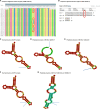Analysis of mutations in mitochondrial transfer RNA genes and the maternal inheritance of polycystic ovary syndrome
- PMID: 40041285
- PMCID: PMC11876027
- DOI: 10.3389/fendo.2025.1509791
Analysis of mutations in mitochondrial transfer RNA genes and the maternal inheritance of polycystic ovary syndrome
Abstract
Introduction: Polycystic ovary syndrome (PCOS) is the most common endocrine disorder in women of reproductive age. Despite the escalating global prevalence, there is currently no definitive predisposition test available for this condition. Among the genetic causes, variations in the mitochondrial DNA (mtDNA) are increasingly recognized as a crucial contributor to the development of PCOS. However, cross-ethnic analysis of these mutations is lacking. To fill in this gap, our objective is to identify new maternal genetic risk factors associated with PCOS by investigating the mitochondrial transfer RNA (mt-tRNA) genes in PCOS patients from Pakistan and to compare these mutations to those in patients from other ethnic groups.
Methods: DNA was extracted from saliva samples of patients. Primers were designed for the amplification of all of 22 mt-tRNA genes, and PCR was employed under defined conditions. Subsequently, Sanger sequencing was employed to decipher the sequences of mt-tRNA genes. Following sequencing, mt-tRNA genes underwent mutation analysis. Finally, we utilized MitoTIP (Mitochondrial tRNA Informatics Predictor) to identify variations in mt-tRNA genes.
Results: In a cohort of 64 Pakistani patients with PCOS, our analysis unveiled eight variants in five mt-tRNA genes including MT-TH, MT-TL2, MT-TS1, MT-TS2, and MT-TT genes. All of these variants have not been previously reported in PCOS except one we have recently identified in a Pakistani patient with PCOS. Interestingly, most of these mt-tRNA genes carry variants found in patients with PCOS across distinct ethnic groups. Furthermore, these mutations occurred in highly conserved nucleotides of tRNA, essential for ensuring the stability and biochemical functionality of mt-tRNA. Finally, the pathogenic potential of these variations was assessed by in silico analysis. The pathogenicity prediction of these variants suggests their potential impact on mitochondrial dysfunction that was responsible for the clinical phenotypes of PCOS.
Conclusion: Our study identified novel variations in mt-tRNA genes in Pakistani women with PCOS. To our knowledge, this is the first report comparing mutations of mt-tRNA genes in PCOS patients across different ethnic groups. Our data revealed common mt-tRNA genes carrying PCOS-associated mutations that may be specific to certain ethnic populations. Together, our work provides new insights into the role of mt-tRNA genes in mitochondrial dysfunction underlying the pathophysiology of PCOS, highlighting mt-tRNA mutations as potential factors for future predisposition tests and more effective therapies for this globally prevalent condition.
Keywords: PCOS; genome sequence analysis; mitochondrial tRNA genes; mutations; pathogenicity.
Copyright © 2025 Nawaz, Awan, Zahoor, Gul, Bibi, Uddin, Abbas, Ghafoor, Belay, Rehman, Li and Tabassum.
Conflict of interest statement
The authors declare that the research was conducted in the absence of any commercial or financial relationships that could be construed as a potential conflict of interest.
Figures




References
-
- Zawadski JK, D A. Diagnostic criteria for polycystic ovary syndrome; towards a rational approach. In: Dunaif A, Givens JR, Haseltine FP, Merriam GR, editors. Polycystic Ovary Syndrome. Blackwell Scientific, Boston, Massachusetts: (1992). p. 377–84.
MeSH terms
Substances
LinkOut - more resources
Full Text Sources
Medical
Miscellaneous

